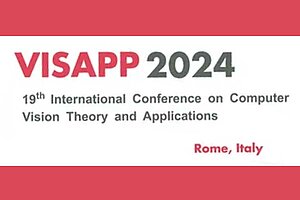March 5, 2024

Researchers from Fraunhofer-Heinrich-Hertz-Institut (HHI) presented seven scientific papers on a wide range of topics at this year's International Conference and Computer Vision Theory and Applications (VISAPP). The papers by researchers from the Vision and Imaging Technologies (VIT) department address current research topics in the "Computer Vision and Graphics" group. VISAPP 2024 took place as part of the International Joint Conference on Computer Vision, Imaging and Computer Graphics Theory and Applications (VISIGRAPP) from February 27 to 29 in Rome, Italy.
With an exceptional number of accepted scientific papers at VISAPP 2024, the CVG group was able to present a wide variety of its research areas.
Clemens Seibold and his co-authors present improved methods for morphing detection in the paper "Towards Better Morphed Face Images without Ghosting Artifacts". The paper "Animating NeRFs from Texture Space: A Framework for Pose-Dependent Rendering of Human Performances" by Paul Knoll et al. examines neural representation for animatable virtual persons. Eric Wisotzky, together with his co-authors, dedicates two papers to multi and hyperspectral imaging, "Multispectral Stereo-Image Fusion for 3D Hyperspectral Scene Reconstruction" and "Efficient and Accurate Hyperspectral Image Demosaicing with Neural Network Architectures". Milena Teresa Bagdasarian's paper "Generative Texture Super-Resolution via Differential Rendering", which she wrote together with her co-authors, addresses AI-based super-resolution of textures for 3D models. Luan Wei et al. also deal with artificial intelligence in "Multi-task Planar Reconstruction with Feature Warping Guidance", where AI is used for scene reconstruction. In the paper "Multi-view Inversion for 3D-aware Generative Adversarial Networks", Florian Barthel and co-authors deal with controllable generative models.
VISAPP considers itself an important platform for the exchange between researchers, engineers and experts in methods, systems and applications of computer vision technology. The conference is dedicated to different aspects of computer vision, including image and video processing and analysis; image and video understanding; motion, tracking and stereo vision; mobile and egocentric vision for humans and robots; and applications and services. All papers presented at the conference are available here.